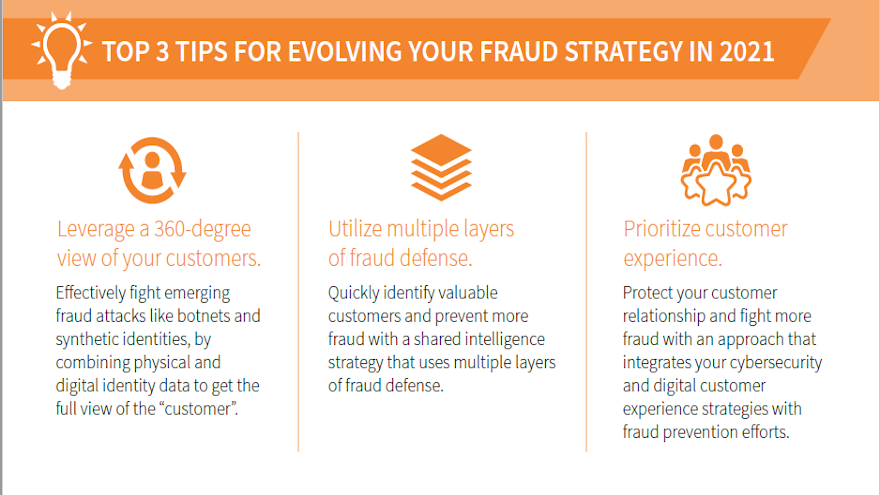LexisNexis Risk Solutions discovers ‘perfect storm’ of fraud in US and Canada amid COVID-19 pandemic

Graphic courtesy of LexisNexis Risk Solutions.
Fraud and its prevention are gaining more attention, especially since the pandemic arrived.
LexisNexis Risk Solutions unveiled findings about what it classified as the current state of fraud, detailing key fraud trends occurring in 2020 for organizations in the United States and Canada while also looking ahead at what to expect in 2021.
LexisNexis Risk Solutions compiled these findings from a review of multiple studies it conducted last year. The consolidation of the report findings showed what it called a “perfect storm” of trends that have impacted fraud throughout the past year and those that may linger into 2021.
Experts said the COVID-19 pandemic caused 2020 to be a year of unique circumstances and disruption to the global economy. One thing that has stayed the same is fraudsters’ willpower to gain access to money and confidential information.
While many believe that fraud victims are mostly the technologically naïve, experts also said 2020 validated that anyone can be a victim. LexisNexis Risk Solutions examined consumer behavior, popular fraud methods, social uncertainty due to the pandemic when compiling this data and suggests what organizations of all shapes and sizes can do to protect their business.
The shift of consumer behavior towards digital transactions
LexisNexis Risk Solutions acknowledged that 2020 saw major changes in the ways in which consumers behave.
The firm’s data showed digital transaction in the U.S. and Canada increased 42% year-over-year leading up to June, with 60% representing mobile transactions; 67% made via a mobile app and 33% made by a mobile browser.
LexisNexis Risk Solutions explained consumers now engage in more digital transactions and use different payment methods that fraudsters leverage to target a broader set of businesses through more sophisticated and complex fraud methods. These actions often involve the mobile channel and the purchase of digital goods and services, according to experts
“Difficult to detect fraud methods like synthetic identities, identity fraud rings, multiple device linkages and bot attacks create identity proofing challenges for businesses,” LexisNexis Risk Solutions said.
“Identity proofing could prove to be a significant challenge for organizations in 2021, as fraudsters leverage digital channels to launch more sophisticated and complex types of fraud,” the firm continued.
According to the Federal Reserve, 86%-95% of applicants identified as potential synthetic identities escape flagging by traditional fraud models.
“This is something every organization should be on the lookout for particularly with the rise in digital transacting,” LexisNexis Risk Solutions said.
Breached consumer data fuels sophisticated fraud methods
LexisNexis Risk Solutions explained this category is more than just about PINs and passwords as this data is valued for both the physical and digital identity attributes linked to transactions and devices, such as email addresses, billing addresses and phone numbers.
The LexisNexis Digital Identity Network indicated a risk in fraudulent events through emails are likely from data breaches and are used by multiple fraudsters.
“Fraudsters are no longer always hidden — they can take the form of a visible business or a network of businesses or devices,” LexisNexis Risk Solutions said. “Physical and digital consumer data is fuel for fraudsters.”
According to analysis from LexisNexis Risk Solutions, 45% of people in the United States having had their personal information compromised by a data breach in the last five years.
“Fraudsters have a trove of personally identifiable information that enables them to use this sensitive information to launch account takeovers and new account creation attacks,” the firm said.
Meanwhile, Javelin estimated that account takeover attacks are up 72% year-over-year while the LexisNexis Risk Solutions Cybercrime Report from January to June found that that one in seven new account creations are likely fraudulent.
Bad actors exploit weaknesses as economic uncertainty continues
Last year, LexisNexis Risk Solutions pointed out overall market and economic uncertainty due to COVID-19 significantly increased successful fraud attempts. Expert said this spike is especially true for the e-commerce, retail, financial services and lending sectors.
“We expect the trend will continue in 2021,” experts said. “While professional fraudsters are always ready to attack, economic hardships can also induce others to engage in fraudulent activities. These can be individuals with no criminal behavior history.”
Typically, LexisNexis Risk Solutions acknowledged, organizations are more sensitive to customer friction during slower economic periods and more concerned about lost opportunities.
“That does not mean they can let their guard down,” experts said. “In addition to those who attack with intent, consumer stress and fear can lead consumers to riskier transaction behaviors, which may increase successful tactics for malware infection on devices and theft of personal identification information.
“This presents more opportunities for fraudsters leading to more attacks,” experts went on to say.
Suggestions of what service providers can do to curb fraud
LexisNexis Risk Solutions recommended that businesses must use both physical and digital identity data to get a full view of their customers to effectively fight emerging fraud attacks.
Experts added that businesses should also utilize multiple layers of fraud defense like actionable decision analytics and investigation tools. This strategy, coupled with integrating their digital customer experience and cybersecurity strategies, will protect the relationships that businesses have with their customers and their information, according to LexisNexis Risk Solutions.
“Businesses can no longer use a check-the-box, incremental approach towards addressing these challenges and trends one at a time because fraud always evolves,” said Kimberly Sutherland, vice president of fraud and identity management strategy at LexisNexis Risk Solutions.
“These factors feed on each other and require an integrated and holistic approach to detecting, assessing and mitigating fraud risks moving forward. 2021 will likely be another challenging year for the world in many ways, but organizations can and should make sure they take a comprehensive view of their customers so that they can effectively fight fraud,” Sutherland went on to say.


